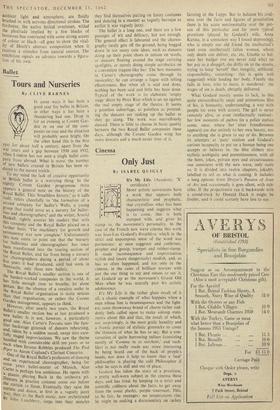Ballet
Tours and Nurseries
By CLIVE BARNES To my mind the lack of creative opportunity in British ballet is a worrying thing. In the nightly Covent Garden programme there appears a general note on the history of the Royal Ballet. This 'breathless history,' as it calls itself, refers cheerfully to 'the formation of a second company for Sadler's Wells, a young group that could serve as a nursery for baller- inas and choreographers,' and the writer, Arnold Haskell, rightly assures his readers that with this company and the Royal Ballet placed on a further basis, 'The machinery for growth and permanence was now complete.' Unfortunately this note omits to point out that the 'nursery for ballerinas and choreographers' has since been transformed into the touring section of. the Royal Ballet, and far from being a nursery' for choreographers during a period of about five years it had produced, until last week in Newcastle, only three new ballets.
, The Royal Ballet's smaller section is one of the hardest-worked companies in the world. It has little enough time to breathe, let alone gestate. But the absence of a creative outlet in the Royal Ballet organisation is more serious than that organisation, or rather the Covent Garden management, appears to think. However, after nearly two years, the Royal Ballet's smaller section has at last produced a new ballet. It is not, however, a particularly goon one. Alan Carter's Toccata uses the fam- iliar backstage gimmick of dancers rehearsing, and, taken by a sudden mood, swept into care- fully staged improvisations. We saw the theme handled with considerable skill ten years or so back when Jerome Robbins produced The Pied rifler to Aaron Copland's Clarinet Concerto.
0tle of the Royal Ballet's professors of dancing and an experienced choreographer, being for 5,...001e years ballet-master of Munich, Alan Carter is perhaps less ambitious. He opens with a pianist playing Bach in the orchestra pit.
the in practice costume come out before
h e curtain to listen. Eventually they raise the Curtain and dance, at first in a vaguely jazzy .1..Y.aY, then as the Bach music, now orchestrated by John I anchbery, seeps into their muscles
they find themselves putting on funny costumes and dancing in a manner as vaguely baroque as earlier it was vaguely jazzy. The ballet is a long one, and there are a few passages of wit and delicacy, but not enough. The general effect is laboured and the choreo- graphy rarely gets off the ground, being bogged down in too many cute ideas, such as dancers doing up their point shoes in unison on stools, or dancers floating around the stage carrying spotlights, or merely doing simple acrobatics on a convenient trapeze-like bar. The best moments in Carter's choreography come through its musicality; he can arrange a fugue with telling effectiveness. But when all is said and done, nothing has been said and little has been done. Typical of the work is its elaborate 'empty stage' decor by Peter Rice which is set up against the real empty stage of the theatre. It 'seems a pointless subterfuge, as pointless as pretend- ing the dancers are making up the ballet as they go along. The work was marvellously danced. There is little to choose in basic quality between the two Royal Ballet companies these days, although the Covent Garden wing has more dancers and a much easier time of it.




























 Previous page
Previous page